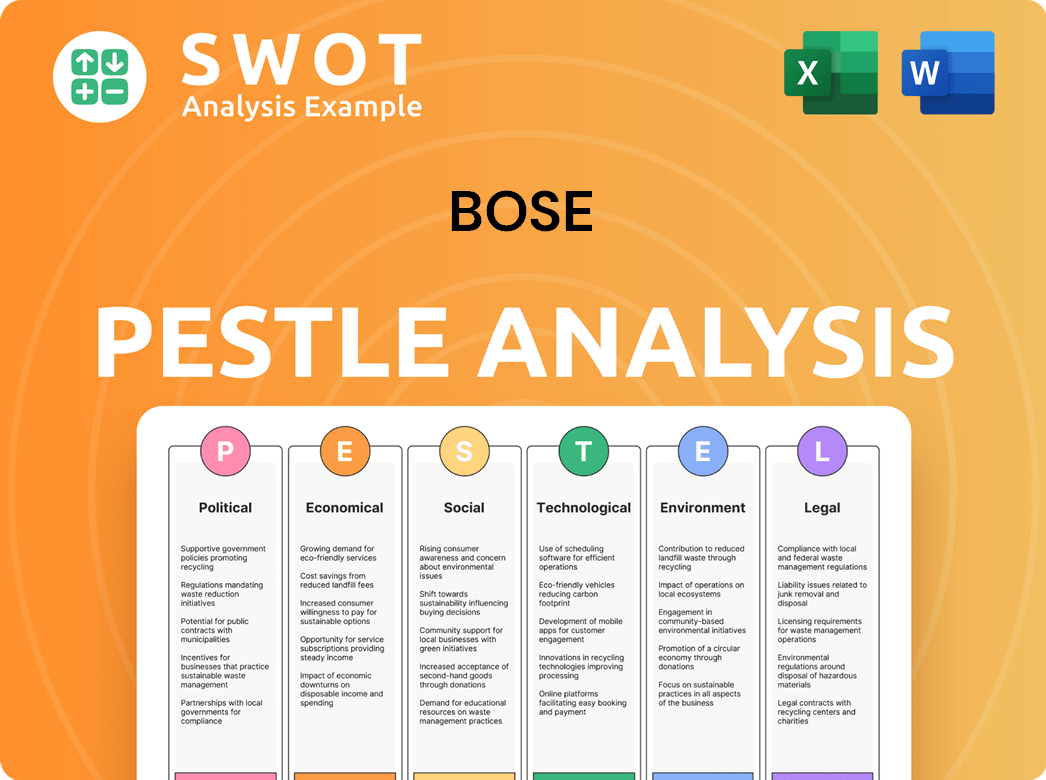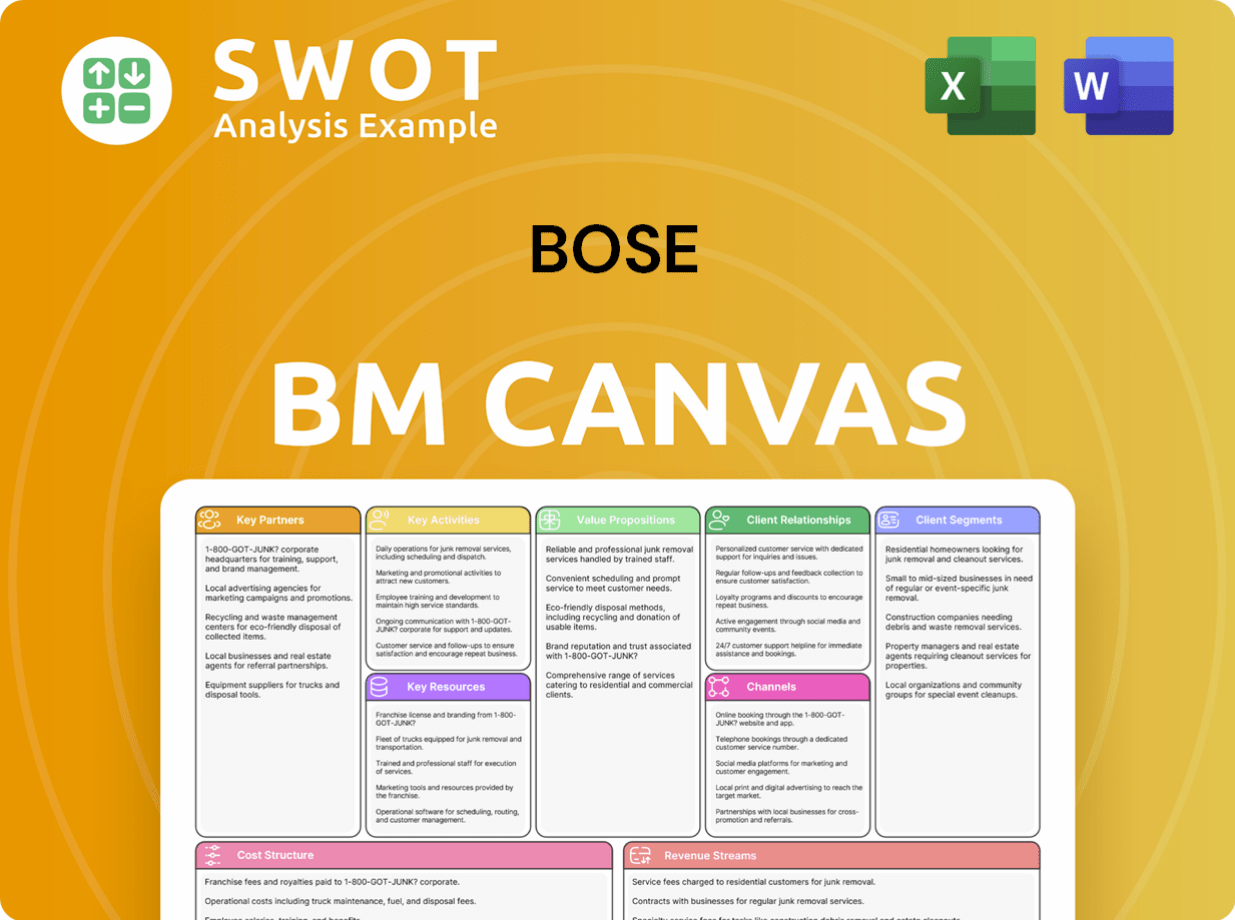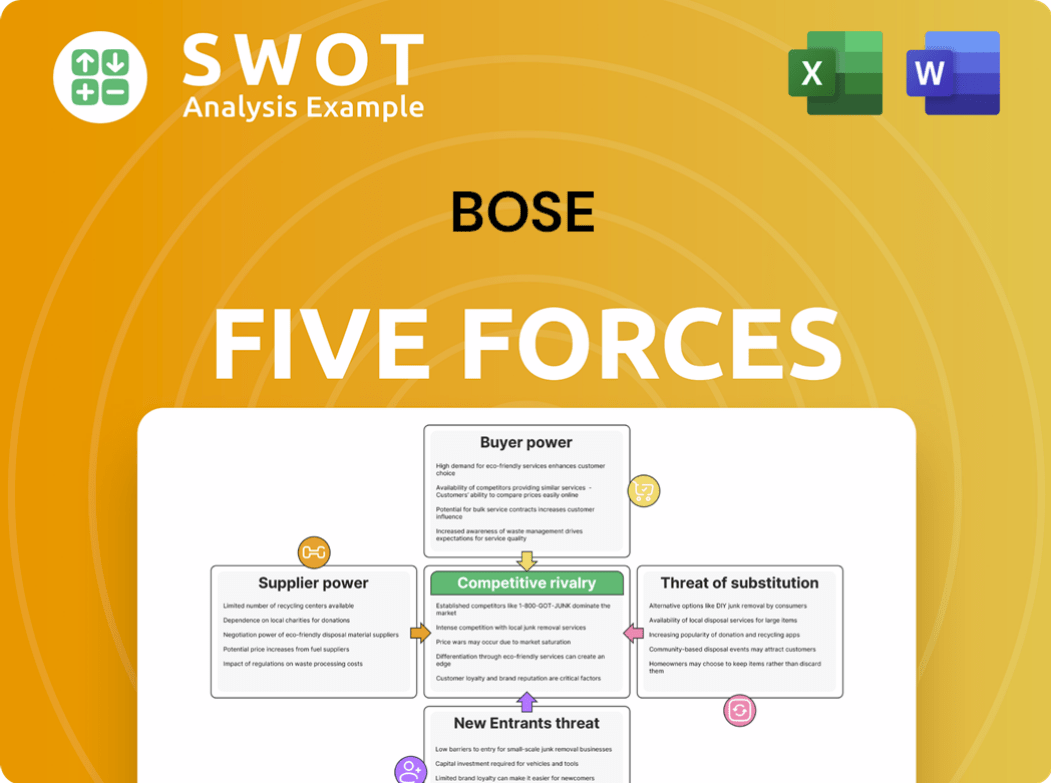Bose Bundle
How Did Amar Bose Revolutionize the Audio World?
Embark on a journey through the Bose SWOT Analysis, a company that redefined audio experiences. From its humble beginnings in 1964, the Bose company has consistently pushed the boundaries of sound technology. Discover the pivotal moments that shaped the Bose history, driven by the innovative spirit of its Bose founder, Amar Bose.

The story of Bose Corporation is a testament to the power of passion and perseverance. Explore the early years of Bose and understand how a personal quest for better sound quality led to groundbreaking Bose products and a lasting impact on the audio equipment industry. Learn about the company's unique ownership structure and its commitment to research, which continues to drive its success today.
What is the Bose Founding Story?
The story of the Bose company is a tale of innovation, driven by a founder's dissatisfaction and a relentless pursuit of better audio experiences. The company's origins are deeply rooted in the vision of Dr. Amar G. Bose, whose personal experience with audio equipment sparked a lifelong dedication to improving sound reproduction.
Dr. Bose's journey began with a simple desire: to replicate the rich, immersive sound of a live concert in the comfort of a home. This ambition led him to challenge the status quo of audio technology, resulting in groundbreaking innovations that would redefine the industry. The early years were marked by both technical breakthroughs and crucial business lessons, shaping the company's trajectory.
Bose Corporation was officially established in 1964 by Dr. Amar G. Bose in Framingham, Massachusetts. Dr. Bose, an electrical engineer and MIT professor, was the driving force behind the company's inception.
- Dr. Bose, born in 1929, started his entrepreneurial journey early by repairing radios.
- The inspiration for the company came from Dr. Bose's dissatisfaction with a stereo system he purchased in 1956.
- He researched acoustics at MIT, focusing on how sound is perceived in concert halls.
- The initial capital of $10,000 came from angel investors, including his MIT thesis advisor.
- The first product, the Bose 2201 speaker, was introduced in 1966.
Dr. Amar Bose, the
The core problem Dr. Bose identified was the inability of existing speakers to accurately reproduce the reflected sound field of a live concert. His vision was to develop speaker systems that used multiple speakers to reflect sound off walls, simulating the immersive experience of a concert hall. Initial funding of $10,000 was provided by angel investors, including his MIT thesis advisor, Y. W. Lee. In the early days, Bose and his small team worked on power-regulating systems for military and government agencies during the day, dedicating their nights to acoustics and speaker design. The first
Bose SWOT Analysis
- Complete SWOT Breakdown
- Fully Customizable
- Editable in Excel & Word
- Professional Formatting
- Investor-Ready Format

What Drove the Early Growth of Bose?
Following initial setbacks, the Bose history saw significant commercial success with the 1968 release of the 901 Direct/Reflecting® stereo speaker system. This innovative design, with eight of nine drivers directed towards the wall, aimed to replicate concert hall acoustics. The 901's commercial success spurred rapid growth for the
The Bose 901 speaker system, introduced in 1968, played a crucial role in the early success of the company. The 901's unique design, which utilized reflected sound, set it apart from conventional speakers. This model remained a key product in their lineup until 2016, contributing significantly to the company's revenue during its long production run.
In 1972, the company established the Bose Professional division, focusing on public address systems. By 2009, this division accounted for approximately 60% of the company's annual revenue, highlighting its importance. This expansion into professional audio systems was a strategic move, diversifying the company's market presence and revenue streams.
The company began selling its
In the late 1970s, the company entered the automotive sound system market. The first OEM audio installation appeared in a 1983 Cadillac Seville. This entry into the automotive sector marked a significant diversification of the company's business, leading to widespread presence in vehicle sound systems for numerous car manufacturers.
In 1993, the company opened its first retail store in Kittery, Maine, expanding its direct-to-consumer reach. This move allowed the company to control the customer experience. This was a strategic move to enhance brand visibility and customer engagement.
The 1980s saw the development of the Acoustic Wave Music System, introduced in 1984. It used patented acoustic waveguide technology. The company also introduced the Acoustimass 5 system in 1987. In 1990, the company launched its Lifestyle speaker systems. The Bose Wave radio debuted in 1993. These innovations solidified the company's reputation for high-quality audio.
Bose PESTLE Analysis
- Covers All 6 PESTLE Categories
- No Research Needed – Save Hours of Work
- Built by Experts, Trusted by Consultants
- Instant Download, Ready to Use
- 100% Editable, Fully Customizable

What are the key Milestones in Bose history?
The Bose history is marked by significant milestones in the audio industry, beginning with the vision of its founder, Amar Bose. From its early years to its current status, the
| Year | Milestone |
|---|---|
| 1968 | Introduction of the Bose 901 Direct/Reflecting® speaker system, revolutionizing home audio. |
| 1972 | Establishment of the Bose Professional division, expanding into public address systems. |
| 1982 | Pioneering factory-installed, custom-engineered sound systems for vehicles, starting with the Cadillac Seville. |
| 1984 | Launch of the Acoustic Wave Music System, utilizing acoustic waveguide technology for compact, high-quality sound. |
| 1986 | Prototype active noise-reducing headsets used by pilots Dick Rutan and Jeana Yeager during their record-breaking flight. |
| 2000 | Introduction of QuietComfort® headphones, redefining noise cancellation in consumer audio. |
| 2009 | Introduction of the QuietComfort 15 headphones, solidifying market leadership in noise-canceling technology. |
| 2020 | Announcement of closing all retail stores in North America, Japan, Europe, and Australia, shifting focus to online sales and partnerships. |
The
The 901 speaker system was a landmark innovation, employing a Direct/Reflecting design to simulate the acoustics of a concert hall. This approach set a new standard in home audio, influencing speaker design for years to come.
The Acoustic Wave Music System utilized patented acoustic waveguide technology. This technology allowed for rich, full sound from a compact unit, becoming one of the company's fastest-selling products.
Bose pioneered noise-canceling technology, initially for pilots, and later for consumers. The QuietComfort series revolutionized air travel and other noisy environments, significantly improving the listening experience.
Bose was among the first to develop custom-engineered sound systems for vehicles. These systems integrated seamlessly into car interiors, enhancing the in-car audio experience.
The QuietComfort headphones series redefined the consumer experience with noise cancellation. This line of products has consistently been a market leader, setting the standard for noise-canceling technology.
SoundTouch systems expanded the company's offerings into wireless multi-room audio. This move reflected the company's adaptation to evolving consumer preferences for connected audio solutions.
Despite its successes, the
In 1970, the 901 speaker system received a negative review from Consumer Reports, leading to a libel lawsuit. Although Bose initially won, the case was eventually lost at the U.S. Supreme Court level in 1983.
In 2014, the premium headphone market saw Beats holding a larger market share (62%) compared to Bose (22%). This competition prompted Bose to innovate and adapt its marketing strategies.
In January 2020, Bose announced the closure of all its retail stores in North America, Japan, Europe, and Australia. This strategic move was made to focus on online sales and partnerships with retailers.
A prototype active suspension system, developed over 20 years at a cost of $100 million, was sold to ClearMotion in 2017. The system was deemed too expensive and heavy for production vehicles.
Adapting to the changing consumer behavior, Bose has focused on online sales and partnerships with major retailers. This shift reflects the company's response to the evolving market landscape.
Bose has been involved in various patent litigations, including a case against Apple in 2014, over noise-canceling technology. These legal battles highlight the importance of intellectual property in the audio industry.
Bose Business Model Canvas
- Complete 9-Block Business Model Canvas
- Effortlessly Communicate Your Business Strategy
- Investor-Ready BMC Format
- 100% Editable and Customizable
- Clear and Structured Layout

What is the Timeline of Key Events for Bose?
The Bose history is marked by significant innovations and strategic shifts. Founded by Amar Bose, the company quickly became a leader in audio equipment. From its early days, the company has consistently pushed boundaries in sound technology, and its trajectory is filled with milestones that have shaped the audio industry. The company's commitment to research and development has led to numerous groundbreaking products and a lasting impact on how people experience sound.
| Year | Key Event |
|---|---|
| 1929 | Amar Gopal Bose, the Bose founder, was born. |
| 1956 | Amar Bose earned his Ph.D. from MIT, and his dissatisfaction with a stereo system sparked his interest in acoustics. |
| 1964 | Dr. Amar G. Bose officially launched Bose Corporation in Framingham, Massachusetts. |
| 1966 | The Bose 2201, the company's first consumer speaker product, was sold. |
| 1968 | The revolutionary Bose 901 Direct/Reflecting® stereo speaker system was introduced, leading to rapid growth. |
| 1972 | Bose established its Professional Products Division and began selling products internationally, starting in Germany. |
| 1983 | Bose's first OEM audio installation appeared in a Cadillac Seville. |
| 1984 | The Acoustic Wave Music System was introduced, becoming the fastest-selling product in Bose history. |
| 1986 | Prototype noise-canceling headphones were used on a historic non-stop flight around the world. |
| 1987 | The Acoustimass 5 system redefined home stereo with compact cube speakers. |
| 1993 | Bose opened its first retail store in Kittery, Maine, and introduced the Bose Wave radio. |
| 2000 | QuietComfort® headphones were introduced, pioneering noise-canceling technology for consumers. |
| 2011 | Amar Bose donated the majority of the company's non-voting shares to MIT. |
| 2013 | Amar Bose passed away; Bob Maresca became CEO. |
| 2020 | Bose announced the closure of its retail stores in North America, Japan, Europe, and Australia. |
| 2020 | Lila Snyder became the first female CEO of Bose. |
| 2023 | Bose made a strategic $10 million investment in Indian wearables startup Noise. |
| 2024 | Bose invested an additional $20 million in Noise, deepening their partnership. |
Bose is focusing on integrating AI capabilities into its product lines. This includes enhancing existing products and developing new smart audio solutions. The goal is to cater to the increasing demand for digital consumer lifestyles, offering more interactive and personalized audio experiences.
The U.S. wireless speakers market, where Bose is a key vendor, was valued at $6.14 billion in 2024. It is projected to reach $12.12 billion by 2030, with a CAGR of 12.00%. Bose is enhancing its products through over-the-air software upgrades and aiming to link its products via a single technology infrastructure.
Bose is exploring corporate venture capital and M&A activities to drive growth. The focus is on software investments in consumer audio and automotive spaces. Strategic partnerships, like the investment in Noise, are key to expanding market presence and technological capabilities.
In fiscal year 2025, Bose plans to launch its first consumer audio products incorporating approximately 20% post-consumer resin. CEO Lila Snyder has affirmed the company's commitment to continuous innovation. The company will continue to push the boundaries of what's possible for its products.
Bose Porter's Five Forces Analysis
- Covers All 5 Competitive Forces in Detail
- Structured for Consultants, Students, and Founders
- 100% Editable in Microsoft Word & Excel
- Instant Digital Download – Use Immediately
- Compatible with Mac & PC – Fully Unlocked

Related Blogs
- What is Competitive Landscape of Bose Company?
- What is Growth Strategy and Future Prospects of Bose Company?
- How Does Bose Company Work?
- What is Sales and Marketing Strategy of Bose Company?
- What is Brief History of Bose Company?
- Who Owns Bose Company?
- What is Customer Demographics and Target Market of Bose Company?
Disclaimer
All information, articles, and product details provided on this website are for general informational and educational purposes only. We do not claim any ownership over, nor do we intend to infringe upon, any trademarks, copyrights, logos, brand names, or other intellectual property mentioned or depicted on this site. Such intellectual property remains the property of its respective owners, and any references here are made solely for identification or informational purposes, without implying any affiliation, endorsement, or partnership.
We make no representations or warranties, express or implied, regarding the accuracy, completeness, or suitability of any content or products presented. Nothing on this website should be construed as legal, tax, investment, financial, medical, or other professional advice. In addition, no part of this site—including articles or product references—constitutes a solicitation, recommendation, endorsement, advertisement, or offer to buy or sell any securities, franchises, or other financial instruments, particularly in jurisdictions where such activity would be unlawful.
All content is of a general nature and may not address the specific circumstances of any individual or entity. It is not a substitute for professional advice or services. Any actions you take based on the information provided here are strictly at your own risk. You accept full responsibility for any decisions or outcomes arising from your use of this website and agree to release us from any liability in connection with your use of, or reliance upon, the content or products found herein.